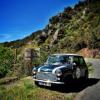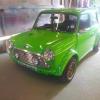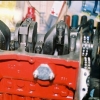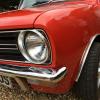
How To Renew Brake Fluid
#1

Posted 22 February 2014 - 10:07 AM
This may be a silly question but what is the best way to replace the brake fluid on my 1994 Mini?
Is it just a question of bleeding the brakes while topping up the reservoir or is there a better method?
The Dummies Guide suggests using a turkey baster to remove the fluid from the reservoir which sounds odd but may just work.
The current fluid has been in there for at least 10 years and probably longer.
#2

Posted 22 February 2014 - 10:20 AM
Fill the easy bleed with about 1/2 litre of fluid fit to the reservoir lid and a tyre with about 15psi
Crack open each nipple in turn starting with the rear
#3

Posted 22 February 2014 - 10:24 AM
1, remove as much old fluid from reservoir as possible (your turkey blaster bit, but I use a fat syringe with rubber tube on the end)
2, refill with clean fluid
3, open ONE bleed nipple (I do the rears first) and pump fluid though until the colour changes to the new fluid (remember to keep the fluid topped up)
4, repeat on other corners
This is much easier of there are two of you. I much prefer doing it this way compared to draining the whole system and refilling as its a lot less hassle on the bleeding front.
#4

Posted 22 February 2014 - 10:41 AM
I would advise on using an eezibleed system, its a one man job and much easier (whoda guess it from its name ;) )
I would do as above and remove as much fluid from the reservoir first and refill partially with new fluid, then check the eezi bleed connects up right and no air escapes around the joins, if thats all good disconnect the bleeder from the tyre, fill the bottle with fluid and reconnect the bleeder then bleed each wheel in the sequence required for your particular car (in haynes manual),
pipes come in the eezi bleed kit to connect to the nipples and that allows you to keep an eye on the fluid colour and when it changes then keep it bleeding for a little longer to be sure of no air pockets and then shut off the valve, move onto the next in the sequence and when all four are done, disconnect the bleeder and check the pedal is firm if not then repeat the process until it is firm.
use the turkey baster (make sure its clean and empty with no old fluid present) to remove a small amount from the reservoir as the eezi bleed tends to fill it to the brim (just make sure the fluid is at max)
If you know anyone with a Halfords trade card then get them to buy the brake fluid, its very cheap on the trade card and I would say get a litre at least as if it needs doing a few times to get rid of air you dont want to run out.
#5

Posted 22 February 2014 - 10:41 AM
#6

Posted 22 February 2014 - 02:58 PM
You will not have a problem getting rid of air, because you will not be allowing air into the system if you keep the Eesibleed well topped up.
But I am seriously concerned at what you are doing. It is good that you are changing the fluid, and please do it every 18 months to 2 years from now on, because that is its maximum safe life. You probably know that it absorbs water, which lowers the boiling point, until, shortly after some heavy braking it boils, and leaves you with no brakes whatsoever for a while. The fluid boiling point now appears to be checked as part of the MOT, but that does not reduce the need to change it anyway, as the absorbed water causes corrosion of the cylinders and pistons. However, if it has not been done for 10 years, that is way over the safe working life of all the rubber components (seals and hoses) in the system, and you urgently need a full hydraulic overhaul, not just fluid replacement. Think carefully about it, it may save your life, or the lives of others. Seal replacement used to be recommended at 40k miles, then reduced to 36k or 3 years, to fit in with the 6k service interval, and my second Mini, not even 2 years old, with single line brakes, had a seal failure at just over 30k, which should not have happened, so there does not seem to be a lot of safety margin in the recommended mileages.
On any classic car I generally fit Kunifer pipes and braided hoses, which never need renewing again, and rebuild all the cylinders with new seals, only if the cylinders themselves are PERFECT. Generally, when they need doing again in 3 years, it is only a new and fairly cheap set of rubbers that are needed, as if the job was done correctly last time, there is unlikely to be significant wear or corrosion of the cylinders.
#7

Posted 22 February 2014 - 03:22 PM
There may be better ways but how I do it is as follows:
1, remove as much old fluid from reservoir as possible (your turkey blaster bit, but I use a fat syringe with rubber tube on the end)
2, refill with clean fluid
3, open ONE bleed nipple (I do the rears first) and pump fluid though until the colour changes to the new fluid (remember to keep the fluid topped up)
4, repeat on other corners
This is much easier of there are two of you. I much prefer doing it this way compared to draining the whole system and refilling as its a lot less hassle on the bleeding front.
Have to say this is the best way for me for years....
Would add to check all the unions to make sure they are dry and inspect the pipe.. Maybe even put some wax on them increase life....and mot inspector at bay...
#8

Posted 22 February 2014 - 04:33 PM
The fluid boiling point now appears to be checked as part of the MOT
Errrr since when and exactly how?
#9

Posted 22 February 2014 - 04:36 PM
I use Castrol Response fluid in all our cars now as it tends not to absorb water so much. It's also lighter in colour meaning it it easier to see when bleeding through.
#10

Posted 22 February 2014 - 04:43 PM
The fluid boiling point now appears to be checked as part of the MOT
Errrr since when and exactly how?
Nothing on the MOT testers site:
MOT Test of Brakes
Brake efficiency and balace is usually checked on a roller brake tester. In certain cases where a roller brake tester may not be used (for example on certain 4-wheel drive vehicles) it may be necessary to check brake efficiency and balance on a road test, with a portable decelerometer.
Inside the car
Electronic parking Brake (EPB) warning device must not be indicating a malfunction
Electronic stability control (ESC) component must not be obviously missing, damaged or inappropriately repaired or modified
ESC wiring must not be excessively damaged
ESC warning lamp must be present, working and not indicating a fault
ESC Swithch must not be insecure or faulty
A brake slack adjuster must not be defective or incorrectly installed
A brake fluid warnimg lamp must not be inoperative or illuminated
Class (v): Electronic braking system (EBS) warning device must not be inoperative or indicating a fault
Anti-lock braking system (if fitted) warning lamp is checked for:
Function
Sequence of operation
Footbrake
Sufficient reserve travel on the footbrake
Pedal rubber not worn to excess
Correct operation of the servo assistance system
ABS and ESC components and associated wiring/switch checked for presence and condition
Parking brake
This could be hand, foot or electronically operated. Checked for reserve travel so that it doesn't reach the stops on application. The mountings will be checked for security and/or corrosion.
The brake lever or control will be a fail if:
missing
insecure
defective or located so that it cannot be satisfactorily operated
any inappropriate repair or modification
During a decelerometer test, if vehicle deviates from a straight line when parking brake applied then this becomes a fail.
Anti-Lock Braking (ABS) and Electronic Stability Control (ESC) Systems
The inspection applies to all systems, original equipment or 'aftermarket'. Will be checked for being fitted (if originally specified), illuminating, not indicating fault, ABS to follow correct sequence.
If ABS or ESC system has been intentionally rendered inoperative the whole system, with the exception of sensor rings or other components which form part of another component.
Reasons for rejection:
component missing, damaged, inappropriately repaired or modified
wiring excessively damaged
Warning Lamp
Missing
Does not illuminate
Indicates a fault
(For ABS) does not follow the correct sequence
ABS or ESC
Component missing or excessively damaged
Wiring excessively damaged
Inappropriately repaired or modified
Switch faulty or insecure
Under bonnet checks
Master cylinder and servo unit are checked for leaks with the engine on and the brakes applied
Servo unit will be checked to ensure it is operating correctly
Visible metal or flexible brake pipes will be checked for corrosion, condition, fouling or leaks
Under vehicle checks
Flexible brake pipes and any other metal brake pipes visible beneath the car are checked
Discs and drums (external only) checked for condition and contamination
Brake back plates and caliper securing devices are checked for condition and security
Condition of the brake pads will be checked if visible
The assistant operates the handbrake and the condition of the linkages and/or cables is checked.
On some vehicles there will be a brake compensating valve beneath the car which will need to be inspected for fluid leaks
General
All components checked for security, condition and operation.
Reason for failure:
Component inappropriately repaired or modified
Insecurely mounted
Excessively weakened
Damaged
Retaining or locking device insecure
Cable, rod or clevis joint insecure
A load sensing valve seized, inoperative, function impaired or incorrectly adjusted
Air brake actuator dust cover missing or not preventing ingress of dirt etc.
Brake performance check
The performance of the front and rear brakes and handbrake are checked for efficiency and balance using specialised equipment.
#11

Posted 22 February 2014 - 04:59 PM
Exactly, worked in this trade for yrs and I know nothing of this, either been current or upcoming. An MOT is only a road worthiness check, so if the brakes work and arent damaged etc etc, then its a pass. Alot of people seem to think an MOT is a full inspection of the car and components, whereas it isnt. Its a set of basic checks carried out visually or with aid of a set arrangement of tools to ensure basic standards are met.
MOT testers arent allowed to remove covers. shields, guards etc.....so in a modern car how are you supposed to check brake fluid and its boiling point? The master cylinder on my clio for example is behind the engine cover which is bolted to the engine.
#12

Posted 22 February 2014 - 05:16 PM
It would be a nightmare for them, if nothing else different grades have different boiling points. It has never been on before and I can't find anything that even suggests it's been looked at.Exactly, worked in this trade for yrs and I know nothing of this, either been current or upcoming. An MOT is only a road worthiness check, so if the brakes work and arent damaged etc etc, then its a pass. Alot of people seem to think an MOT is a full inspection of the car and components, whereas it isnt. Its a set of basic checks carried out visually or with aid of a set arrangement of tools to ensure basic standards are met.
MOT testers arent allowed to remove covers. shields, guards etc.....so in a modern car how are you supposed to check brake fluid and its boiling point? The master cylinder on my clio for example is behind the engine cover which is bolted to the engine.
#13

Posted 22 February 2014 - 05:37 PM
Well, I have seen brake fluid boiling point recorded on my MOT sheet several times (the working sheet which they used to complete by hand, until a few years ago). It is also done in the regular service for my daily driver, and shows in the check sheet. There is a very simple electrical instrument available for checking it, which involves removal of the reservoir cap. It may be that the particular garages concerned just feel that it is necessary, which is is I suppose, even if not called for in the MOT test. Personally, I KNOW that my fluid is ok, and would prefer that the test was not done, as there is always the risk of dirt ingress when the lid is removed. One garage forgot to put the cap back once, which is why I am absolutely certain that it had been off. Funnily enough, that one had silicone fluid, and a label saying so, and definitely did NOT need checking!
#14

Posted 22 February 2014 - 05:38 PM
#15

Posted 22 February 2014 - 06:08 PM
As this is a trade I work in, I was merely providing the correct information. No attack on anyone.
1 user(s) are reading this topic
0 members, 1 guests, 0 anonymous users




















